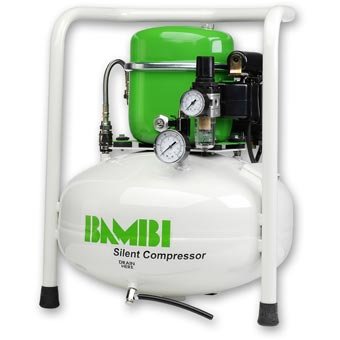Topic: Airbrush Compressor

Airbrushing lets you create fantastic pieces of art, using only colour applied by a fine jet of air. If you replace the colour with fine grains of sand, you can even use it to etch in glass, creating long lasting decorations that won't fade. But airbrushing is not only limited to artists working in bakeries, tattoo studios, galleries etc. You can use it to apply spray tan and even airbrush makeup. It would be nice if you could just plug a siphon gun into whichever air compressor and start airbrushing, but it isn't that simple. That's why we will go through the basics of airbrush compressor in this article.
First up, noise level?
For those of you who taught that all air compressors are hideous loud monsters, think again. Today you can get air compressors not making more noise than you refrigerator while they're running. This of course comes at a cost so you should have a budget in mind before you continue reading.
If noise doesn't matter since your airbrush compressors is stored in the basement and you're airbrushing on ground floor, there are some money to save. And ordinary piston compressor with a 4-8 gallon air tank should do. You can purchase these practically everywhere for around $100-200. Done deal. Ingersoll Rand and Campbell Hausfeld are popular brands.
If noise matters a little, you could buy a mini air compressor these are small and usually generates less noise because of their size an nothing else. There are also models on the market labelled as silent compressors. My rule however is: if they are big, they are loud. So buying a normal piston compressor and expecting that you can use it while your wife or husband watches TV, is like hoping for a miracle to happen. If silent is what you want, or need, se below.
For those of you who have a professional studio where clients can't be disturbed, or you are airbrushing in the same room as the airbrush compressor is, a silent airbrush compressor is what you need. They cost roughly the double of a similar noisy air compressor would have, but in return, they are unbelievably quiet. These compressors have soundlevels of about 30-40 dB, which is considerably less, compared to a regular compressor with around 75-85 dB. Silent Air, Bambi, and Cole-Parmer are recognized manufacturers of quiet air compressors.
Second, air tank?
The air tank acts as a buffer, storing energy and letting the compressor stop once in while to cool down. So do you need one?
Airbrush Compressor with air tank is my choice if I am to do any airbrushing by free hand, without stencils. My argument here is that air compressors create pressure pulses as they compress air, these pulses are equaled out in the air tank, giving a more consistent and even spray of air and colour. If you wonder what the size of the air tank should be, you can roughly estimate it by saying you need one gallon of air tank, per CFM air consumption.
The no air tank option is for the air brush artist who uses airbrushing together with stencils, on projects where you could have used a sponge, or paint brush.
Third, air quality?
To achieve optimum results we need air of optimum quality and pressure. This is why I always use a water/oil trap, an air filter and a pressure regulator for my air brush equipment. A water/oil trap is also known as a coalescing filter and removes droplet from the air. The air filter is pretty cheap and removes almost all solid particles from the air. As close to my workstation as possible I set up my pressure regulator. By having it close I can easily adjust the air pressure to get the perfect spray out of my airbrush gun.
Find more articles about airbrush compressors by clicking this link
Updated: Monday, 6 January 2014 11:04 PM EST
Post Comment | Permalink | Share This Post

